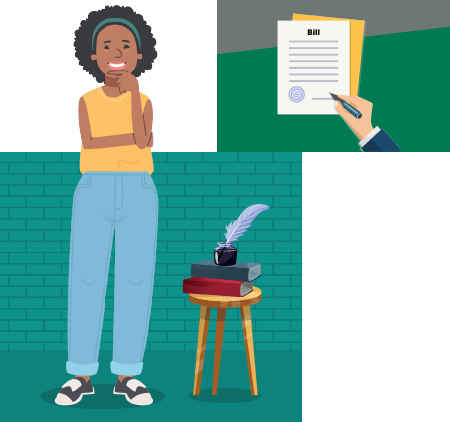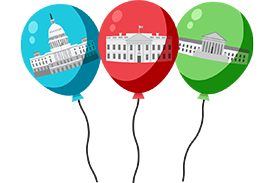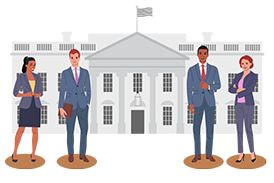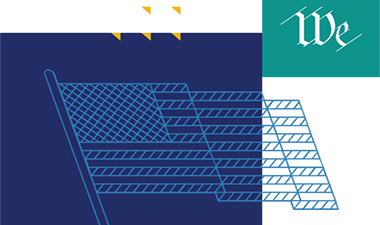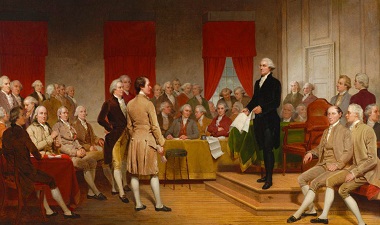
Getting Started
This module includes an Unboxing the Constitution video (5 min), Inside the Constitution video (6 min), student activities, and a learning project. Download the Teachers Guide and the Student Content Guide for more details on content and implementation. Course materials are provided in Google documents, Word documents, as well as printable PDFs.
A preview of the module can be accessed below.
Topics covered include:
- Text of Article I
- How a bill becomes a law
- Congressional power throughout history
- Key Supreme Court cases

Vocabulary
At the beginning of each module, students are presented with vocabulary words and definitions.
Concept Words
Concept words are conceptually related to the big ideas in what they’re learning. These connect directly to the core concepts or themes of the lesson or unit and help students grasp the main ideas and how everything fits together.
- bicameral: having two chambers or houses
- checks and balances: a system where each branch of government can limit the power of the other branches
- clause: a part of a written document, like a law, that explains a specific rule or condition
- congress: the part of the U.S. government that makes laws; it is made of of two houses, the Senate and the House of Representatives
- House of Representatives: the lower and larger house in the U.S. Congress
- landmark ruling: an important decision made by a court that changes the way laws are understood or applied
- Senate: the upper and smaller house in the U.S. Congress
- separation of powers: dividing government powers into different branches
Speed Bump Words
Speed bump words are words that aren’t central to the concept being taught, but if students don’t understand them, they may struggle to comprehend the text or lesson. These words can help shape students' overall understanding of the topic.
- circumspection: being careful and thinking about risks before acting or making a decision
- consensus: when most people in a group agree on something
- deliberation: talking and thinking carefully about something before making a decision
- discrimination: treating people unfairly, commonly because of their race, gender, or other difference
- excesses: actions that represent an overreach of power
- faction: a group of people who are acting in their own self-interests
- framework: a basic plan or structure that helps organize and support something
- jarrings: loud or harsh disagreements or conflicts between people or groups
- limitations: things that stop or restrict what you can do, such as rules or boundaries
- mandate: an official order or command to do something
- monopoly: when a company or group controls all or most of the supply of a product or service, leaving little or no competition
- obstruct: to block or stop something from happening
- reconcile: to bring two parts together in agreement
- salutary: something that is helpful
- scope: the range or extent of something, like how big or far-reaching it is

Topic 1: The Role and Responsibilities of the Legislative Branch
The concept of separation of powers and checks and balances was critical to ensuring that no one branch of this new national government would have too much power or influence. Many founders considered the legislative branch of government the most powerful and, therefore, potentially the most dangerous.
7.1: Activate Prior Knowledge
To start engaging with the content in this module, students will collaboratively brainstorm words, names, and phrases related to Congress.
Unboxing the Constitution
In this Unboxing the Constitution video, Lucy explains key concepts related to Article I and the legislative branch.
7.2: The Circus
Students will examine a political cartoon about the legislative branch, either individually or as a class, and consider what they notice, the symbols included, and the illustrator’s intended message. Review the Teachers Guide for more insight on discussion questions and connections.
7.3: Inside Article I
Where are the roles and responsibilities of Congress outlined within Article I? Students will explore this part of the Constitution to find examples of things like legislative power, elections, and the lawmaking process.
7.4: A Bill Becomes a Law
How does a bill become a law? Students will work to put the steps of how a bill becomes a law in the right order.
7.5: Closing Activity
Students will check in on the Key Question(s).

Topic 2: Congress Over Time
Over decades, Congressional powers have been shaped by several Supreme Court rulings, often redefining the balance of power within our government. In fact, several key court decisions influenced the role of Congress and its place in the federal system. By interpreting the Constitution, the Court has clarified how far congressional authority extends.
7.6: Clauses
Students will watch the Inside the Constitution video to gain insight into the Commerce Clause and the Necessary and Proper Clause and organize their thoughts in the Video Notes handout.
Inside the Constitution
7.7: Explore the Cases
Students will review key Supreme Court cases dealing with questions around congressional power. Consider how these cases have both expanded and limited Congressional power throughout history.
7.8: Civic Connection: Create a Bill
In this Civic Connection activity, students will consider issues that matter to them and think about how they would write that into a bill to become a law.
7.9: Reflect
To end this module, students will revisit the brainstorming activity and Key Questions from the module to see how insights have grown throughout the lesson.

Learning Project
In this activity, students will step into the shoes of members of Congress and experience the process and challenges of crafting a bill that is consistent with the Constitution. To craft their law, students will select from one of the following categories or identify a new issue:
- Education and School Life
- Environmental and Community Issues
- Technology and Social Media
- Public Health and Safety
- Transportation and Infrastructure
- Taxes
- Business and Economic Growth





